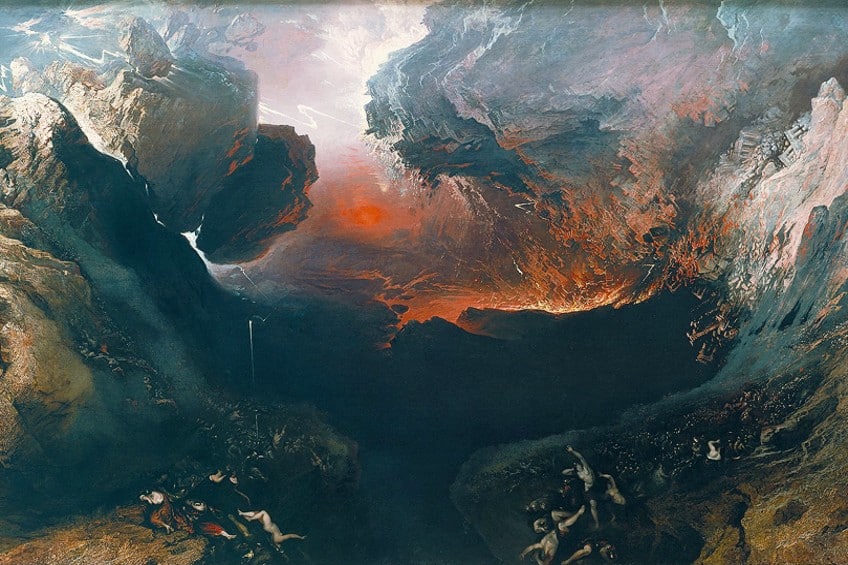“The Great Day of His Wrath” by John Martin – Exploring the Work
John Martin often painted scenes that were grandiose and sublime. These touched on the deeper and quite hair-raising sides of life and death, notably the apocalypse, implicating just how insignificant man can be when nature and God-like forces are involved. This is what his Romantic painting, The Great Day of His Wrath (1851 – 1853), recalls. You can read more about it in the article below.
Artist Abstract: Who Was John Martin?
John Martin was an English Romanticist painter. He was born on July 19, 1789, and died on February 17, 1854. His birthplace was the village called Haydon Bridge in Northumberland in England. He started heraldic painting from an early age and studied under artists like the Italian Bonifacio Musso. Martin was known for his landscapes and themes that related to the Bible, often related to the apocalypse.
Some of his famous artworks include Belshazzar’s Feast (1820), Pandemonium (1825), and The Deluge (1834).

The Great Day of His Wrath (1851 – 1853) by John Martin in Context
| Artist | James Martin (1789 – 1854) |
| Date Created | 1851 – 1853 |
| Medium | Oil on canvas |
| Genre | Landscape/Religious painting |
| Period/Movement | English Romanticism |
| Dimensions (centimeters) | 197 x 303 |
| Series/Versions | Part of a triptych titled The Last Judgment |
| Where Is It Housed? | Tate Britain, London, England |
| What It Is Worth | It was bought by the Tate Britain in 1945, reportedly for £100. |
The analysis below will explore The Great Day of His Wrath painting by James Martin, starting from when he painted it and that it is a part of a triptych. It will then discuss the formal art elements that compose the painting and what the subject matter consists of.
Contextual Analysis: A Brief Socio-Historical Overview
The Great Day of His Wrath by John Martin was originally part of a triptych (a triptych is a form of artwork composed of three panels that are usually painted) titled The Last Judgment (1851 – 1853). The adjoining two panels are titled The Plains of Heaven (1851 – 1853) and The Last Judgement (1853), the latter of which was reportedly the last painting and allocated for the center of the triptych. The Plains of Heaven, which is the painting on the left of the triptych, depicts a serene nature-filled scene suggestive of salvation and heaven. This is also a continuation of the central painting, The Last Judgement.
In The Plains of Heaven painting, there are several angel-like figures and what appears to be cherubs in the middle ground and on an embankment that overlooks an expanse of still waters.
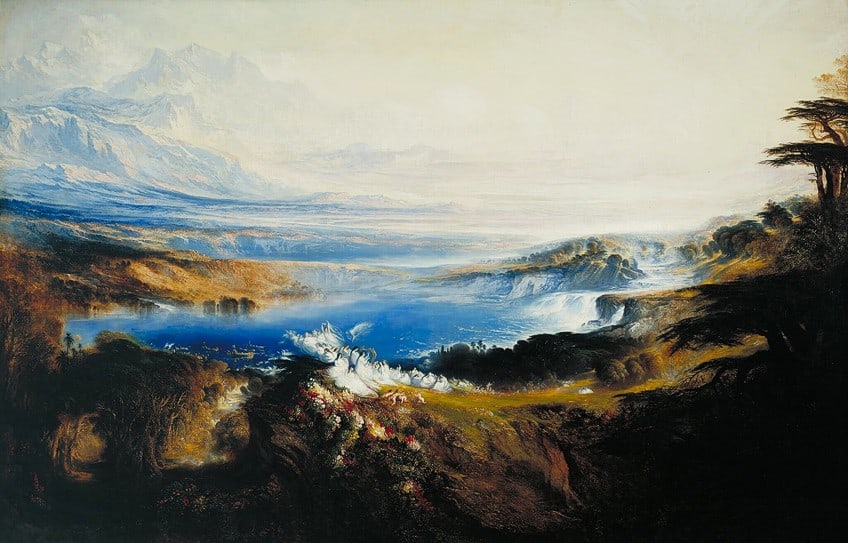
In the far distance, a white mountain region that seems to blend in with the white of the skies above. The central painting, The Last Judgement, depicts God on the Throne in the background, resplendent in white and surrounded by angels and what has been described as the “four and twenty elders”.
Theme and Inspiration
The theme of John Martin’s triptych, as the title suggests, is about the end times, the apocalypse and salvation, and more specifically the Bible’s account from the Book of Revelation in the New Testament. Additionally, it is important to note other proposed interpretations around John Martin’s inspiration for The Great Day of His Wrath painting, notably from his son, Leopold Martin.
The latter has reportedly stated that John Martin was inspired by the Black Country when he undertook a “night journey” through it.
The Black Country is in the Midlands of England and comprises the boroughs known as Dudley, Sandwell, Walsall, and Wolverhampton. This was an area of significant production of coal and iron during the mid-1900s and has often been thought to have been named after all the soot. Another reason for its name has been tied to the area’s prolific coal seam. Interestingly, Elihu Burritt, who was an American Consul in Birmingham, reportedly described the Black Country as “Black by day and red by night”.
Formal Analysis: A Brief Compositional Overview
The formal analysis of The Great Day of His Wrath (1851 – 1853) by John Martin will start with a discussion of what the subject matter is composed of, looking at the destruction and natural disasters in full swing. This will be followed by how the elements of art like color, texture, line, shape, form, and space arrange the composition to create such a visually impactful scene.
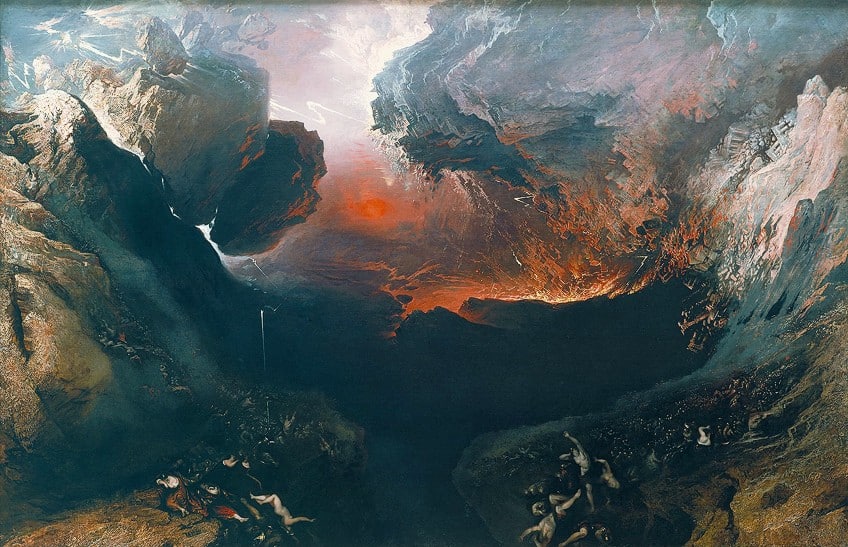
Subject Matter: Visual Description
In The Great Day of His Wrath painting John Martin depicts a vast landscape, darkened by the destruction taking place. There appear to be mountainous regions on both sides of the composition and a large, black, abyss-like gorge opening in the middle as if engorging all that is around it.
The foreground depicts masses of people all frantically falling towards and into the large engorging crevasse in the middle. They are depicted on both sides of the mountains in the foreground, and some appear clothed, half-clothed, naked, and out of control as they roll down the rocky slopes.
Some of the people who are clearer in view in the foreground appear to be in anguished states, for example, in the lower left corner is a woman hunched over a rock appearing to be crying, and her left hand is covering her face. Another woman behind her appears to be praying, both her hands are intertwined and held up in a gesture of prayer.

This is not just any natural landscape though, if you look on the right, there are remnants of a cityscape on the mountaintops that are busy breaking away as the earthquake shakes it all loose causing it to fall into the crevasse below. Directly opposite, on the left side, are two large boulders also breaking away. On the right side, in the middle ground, is a section of red light illuminating the darkened landscape. Is this light coming from below? The background depicts slivers of the sky and clouds that appear to be blocking the blood-orange orb of the sun around the horizon. The upper left corner appears lighter and brighter with slivers of lightning flashing through the rocks.
Color and Value
The colors composing The Great Day of His Wrath by John Martin consist of a variety of browns, grays, whites, blacks, and warm reds, oranges, and pinks that all create earthy and fiery effects within the depicted landscape.

Texture
There is implied texture in The Great Day of His Wrath by John Martin, for example, notice the rough and craggy appearance of the boulders and mountains, the smooth skin of the people in the foreground, or the softer and fluffy appearance of the clouds in the background.
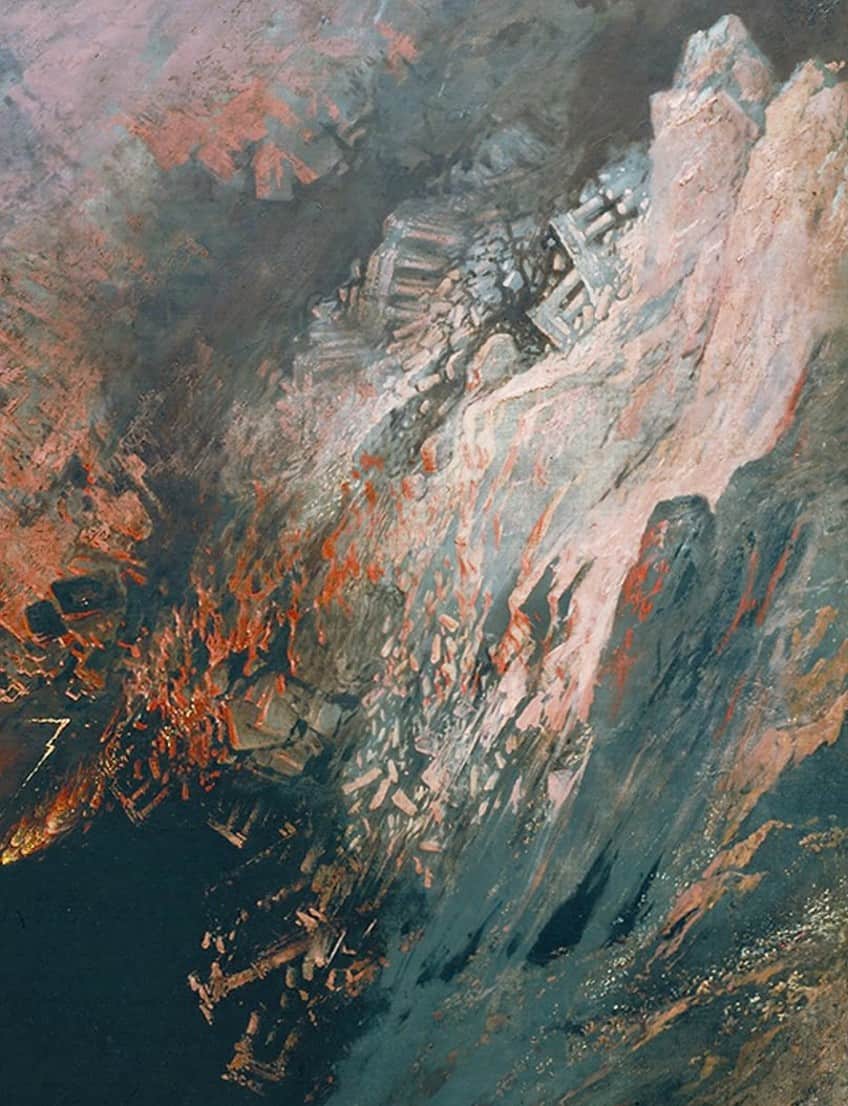
Line
The Great Day of His Wrath by John Martin consists of a variety of lines that create a naturalistic scene. There are almost no visible outlines, but lines are suggested by how the colors blend into one another. Some of the types of lines evident are irregular and diagonal, for example, the mountains and rocks, all of which create more movement and dynamism.
There are some lines that appear more curled and curved for the clouds, and some straight lines that compose the buildings on the right. Notice the long, straight line from the lightning bolt, which also appears zigzagged in parts.
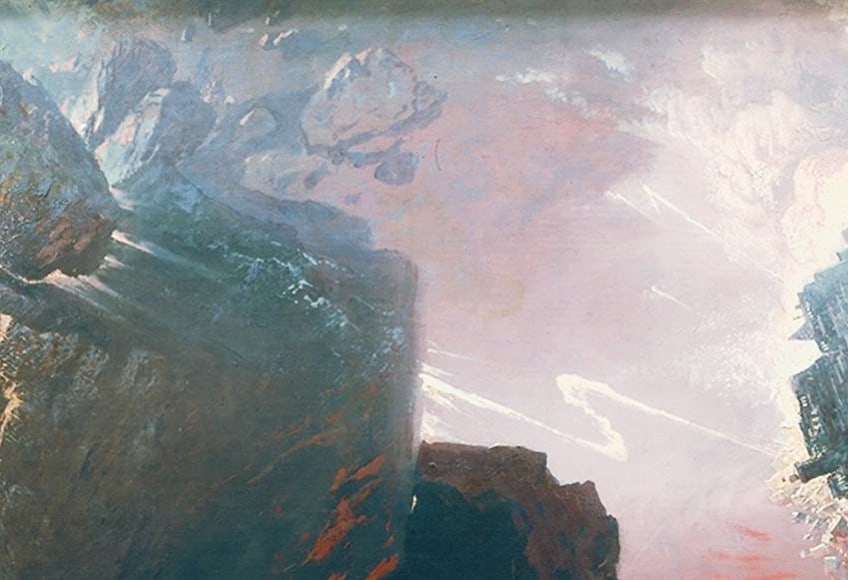
Shape and Form
The Great Day of His Wrath by John Martin consists of naturalistic shapes and forms and with the application of other art elements like color to create shading effects, there is also a sense of depth to the composition, further enhancing its realism and/or naturalism.

Some of the shapes and forms that occur are the square or rectangular shapes that compose the buildings on the right, notice the cylindrical forms of the columns of the buildings. There are irregular and craggy formations of the mountain’s rocks.
Space
There is a sense of depth in The Great Day of His Wrath by John Martin, which is created by other art elements like color and contrasts of light and dark, for example, notice the stark transitions of almost black shadows against the red lava-like light emanating in the background.
Additionally, depth is also depicted through scale and size, for example, the figures in the foreground are larger, and clearer in view than the figures further into the background.

An Epic Tale
The Great Day of His Wrath, along with the other two paintings, Plains of Heaven and The Last Judgement, in John Martin’s triptych, The Last Judgment, were signed by John Martin to be converted into engravings by Thomas Maclean, who was a publisher. The paintings were reportedly first exhibited in Newcastle, then throughout Britain, and including Australia. John Martin reportedly died just several days after the paintings’ exhibition in 1854.
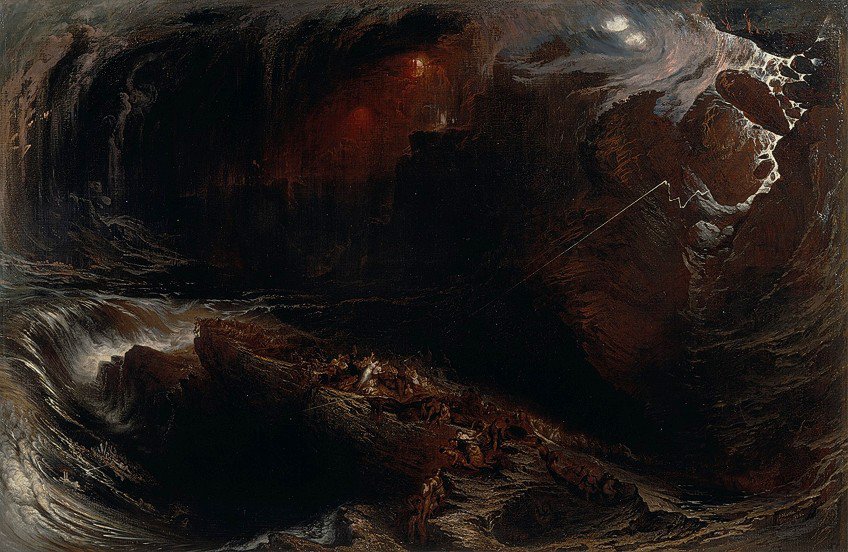
This article discussed The Great Day of His Wrath painting by John Martin, which is based on the narratives or prophecies from the Bible’s Book of Revelation. It is a stunning visual story about the end of times, depicted on a large canvas that undoubtedly would have evoked awe and wonder in the thousands of viewers.
While there is so much more left to talk about, such as the Biblical and socio-historical contexts of John Martin’s The Great Day of His Wrath painting, one of its main areas of discussion has been around the ideas of the sublime. It showcases these ideas on a large scale, which caused ripples in the waters of 19th-century society.
Frequently Asked Questions
Where Is The Great Day of His Wrath by John Martin?
The Great Day of His Wrath (1851 – 1853) by John Martin is located at the Tate Britain in London, England. It was reportedly purchased for £100 by the Tate Art Gallery in 1945.
What Does The Great Day of His Wrath by John Martin Mean?
The Great Day of His Wrath (1851 – 1853) by John Martin is about the end of the world, notably the events from the Book of Revelation from the Bible’s New Testament. Martin was also reportedly inspired by the Black Country when he traveled through it, and the development of industrialism could have inspired him.
Is The Great Day of His Wrath by John Martin Part of a Series?
The Great Day of His Wrath (1851 – 1853) by John Martin is one of the paintings that are part of the triptych titled The Last Judgment (1851 – 1853). The other two paintings include The Plains of Heaven (1851 – 1853) and The Last Judgement (1853).
Alicia du Plessis is a multidisciplinary writer. She completed her Bachelor of Arts degree, majoring in Art History and Classical Civilization, as well as two Honors, namely, in Art History and Education and Development, at the University of KwaZulu-Natal, South Africa. For her main Honors project in Art History, she explored perceptions of the San Bushmen’s identity and the concept of the “Other”. She has also looked at the use of photography in art and how it has been used to portray people’s lives.
Alicia’s other areas of interest in Art History include the process of writing about Art History and how to analyze paintings. Some of her favorite art movements include Impressionism and German Expressionism. She is yet to complete her Masters in Art History (she would like to do this abroad in Europe) having given it some time to first develop more professional experience with the interest to one day lecture it too.
Alicia has been working for artincontext.com since 2021 as an author and art history expert. She has specialized in painting analysis and is covering most of our painting analysis.
Learn more about Alicia du Plessis and the Art in Context Team.
Cite this Article
Alicia, du Plessis, ““The Great Day of His Wrath” by John Martin – Exploring the Work.” Art in Context. December 26, 2023. URL: https://artincontext.org/the-great-day-of-his-wrath-by-john-martin/
du Plessis, A. (2023, 26 December). “The Great Day of His Wrath” by John Martin – Exploring the Work. Art in Context. https://artincontext.org/the-great-day-of-his-wrath-by-john-martin/
du Plessis, Alicia. ““The Great Day of His Wrath” by John Martin – Exploring the Work.” Art in Context, December 26, 2023. https://artincontext.org/the-great-day-of-his-wrath-by-john-martin/.


